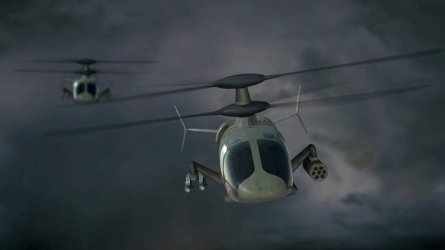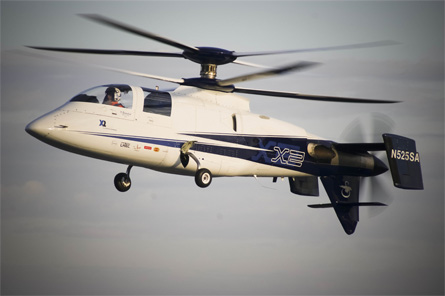Building on the record-breaking X2 demonstrator, Sikorsky has launched the S-97 Raider programme to fly and test a high-speed scout and attack helicopter.
The coaxial-rotor, compound helicopter, scheduled to complete first flight within 50 months, will carry weapons and troops like the Russian Mil Mi-24, but fly faster than 200kt (370km/h) in cruise, and 220kt in dash mode, Sikorsky says.
By officially unveiling the S-97 programme on 20 October, Sikorsky intends to challenge the US Army's requirements staff as they consider options for replacing the Bell Helicopter OH-58D Kiowa Warrior.
"If we don't do this now, that requirement is going to show up for a standard helicopter that does things 8-10% better," says Sikorsky president Jeff Pino, unveiling a mock-up of the 4,760kg (10,500lb) maximum gross weight S-97.
 |
|---|
© Sikorsky |
The army is evaluating options for the armed aerial scout (AAS) contract, with a decision on its acquisition strategy timed for the second quarter of 2011.
The potential order for hundreds of scout helicopters has sparked a wide range of responses from industry. Two weeks ago, Bell Helicopter unveiled a new demonstrator project to re-engine a Kiowa with a Honeywell HTS900-2 engine. EADS North America has teamed with Lockheed Martin to convert an EC145 single-rotor helicopter into the AS645 armed scout.
Despite Sikorsky's high-speed proposal, the army has not specifically asked for a faster helicopter than the Kiowa Warrior. But service officials last December asked industry to propose helicopters that can hover out of ground effect at 6,000ft (1,800m) when the outside temperature is above 35ºC (95ºF) - a limitation for most single-rotor helicopters in places like Afghanistan.
The S-97 is designed to hover carrying six fully equipped soldiers at that extreme altitude, Pino says. If the payload is only weapons, sensors and fuel, the S-97's hover ceiling rises to 10,000ft, he adds.
Sikorsky, however, is not counting on the AAS programme alone to justify the business case for launching a new aircraft. The S-97 also will be pitched to other potential US and foreign military customers over the next decade.
Pino cited the US special operations community - specifically, infiltrating navy SEALs on covert missions - as a possible buyer for the S-97, which operates quietly and without a tail rotor.
"I won't say it is 'Airwolf-whisper' quiet," Pino says, citing a 1980s American TV series featuring a supersonic Bell 222 helicopter. "But it's very, very, very, very quiet."
The aircraft also could be adopted by the US Marine Corps as a high-speed, armed escort for the Bell Boeing V-22 Osprey tiltrotor.
"AAS is not the only game in town," Pino says.
Sikorsky plans to complete a preliminary design review with its suppliers, who are contributing 25-30% of the S-97 development funding on a risk-sharing basis, in 2011.
Two S-97 prototypes will be built for the test programme. The aircraft will use the existing General Electric T700 engine for the prototypes. A more powerful, 2,300shp (1,720kW) engine, however, must reach fruition under the army's improved turbine engine programme (ITEP).
"ITEP has to come through," Pino says. "We're going to need those [extra] horsepowers."
Sikorsky has displayed a mock-up with three-bladed rotors, but the S-97 will use four blades on each rotor to counter vibration levels. The pusher propeller attached to the tail will measure 2.04m in diameter.
The S-97 is the first all-new helicopter that Sikorsky has launched since the army cancelled the Sikorsky/Boeing RAH-66 Comanche in February 2004.
A year later, Sikorsky hatched the idea for the X2 demonstrator after internally deciding that high-speed would be the next capability desired by the military.
 |
|---|
© Stephen Trimble/Flightglobal |
The X2 demonstrated 250kt speed in level flight in September, breaking the helicopter speed record with the advantage of a pusher propeller providing 1,500lb (6.7kN) of augmented thrust.
Unlike the X2, the S-97 will incorporate a gearbox on the propeller to allow the pilot to disengage or engage the propulsor in flight. If the programme advances to the production stage, Sikorsky also plans to install a cockpit with the ability to fly with two pilots, one pilot or autonomously.
Sikorsky has reserved space in the S-97 to install a targeting sensor with a forward-looking infrared camera, but it will not be included in the demonstration programme.
Source: Flight International



















